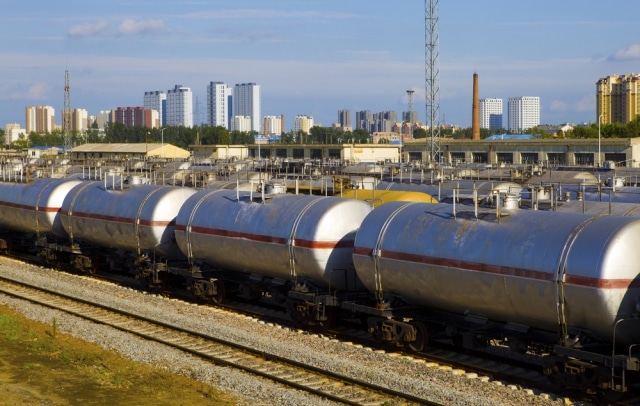In 2009, Matt Taibbi wrote a piece in Rolling Stone in which he described the investment bank Goldman Sachs as “a great vampire squid wrapped around the face of humanity, relentlessly jamming its blood funnel into anything that smells like money.”
Apparently tar sands oil smells like money. And thus the vampire squid has found another target. As Reuters reported on August 29:
A Goldman Sachs-led rail terminal operator, USD Group LLC, announced on Friday plans to form a Master-Limited Partnership this year to trade publicly on the New York Stock Exchange.
This new company will be based around a tar sands rail loading facility in Hardisty, Alberta. That is the same place where the proposed Keystone XL pipeline would begin. USD Group already owns a crude-by-rail terminal in the town, with capacity to load two 120-car unit trains per day.
And with the success of this first phase of development, the company has announced plans to double the capacity of the terminal, which would allow it to load 280,000 barrels per day (bpd). The company has also announced plans to add another 70,000 bpd, which would bring its capacity to 350,000 bpd, or roughly half the proposed capacity of TransCanada’s Keystone XL pipeline.
There is an interesting twist to this story. In June 2013, at the same time that USD Group was beginning to construct its tar sands-by-rail loading facility in Hardisty, Goldman Sachs released a report, titled Getting Oil Out of Canada, about tar sands logistics, which outlines the reasons why moving tar sands by rail would be difficult. This report was widely cited by environmental groups to show why stopping the Keystone XL pipeline is vitally important.
Saying one thing while doing another is something Goldman has had success with in the past. During the housing crisis, Goldman was selling its own clients mortgage-backed securities that Goldman knew were doomed and then they were intentionally betting against those same securities with Goldman’s internal funds. It was a strategy that proved to be very lucrative.
In its June 2013 report, Getting Oil Out of Canada: Heavy Oil Diffs Expected to Stay Wide and Volatile, Goldman cites the need for steam-jacketed rail cars as one of the challenges.
The first hurdle is that bitumen/heavy crude oil rail cars have to be specially made, so that their viscous cargo can be heated by steam in order to flow the crude out of car.
In the recent announcement detailing the assets of USD Group, note the inclusion of “a railcar fleet consisting of 3,799 railcars as of August 1, 2014.”
In its 2013 report Goldman also made predictions about future Canadian oil-by-rail capacity.
We estimate that rail capacity is currently about 150,000 b/d of crude oil from Western Canada to the United States, and is expected to grow to at least 200,000 b/d in 2014.
This is an interesting prediction since USD Group’s capacity, which came on line in mid-2014, is approximately 140,000 bpd. That alone would have made Goldman’s estimate a big miss. Meanwhile, Reuters reported in June 2014 that it expected 1.1 million barrels per day to be online in Canada by the end of 2014.
In addition to underestimating rail capacity (while owning a significant part of a company building that capacity), the Goldman report gave price estimates for Western Canadian Select (WCS), the industry name for tar sands oil blends. The report predicts a base-case scenario of WCS at $64 per barrel in 2014 and worst case (bear) price of $50 per barrel and a best case (bull) of $72.80 per barrel. These lower estimates for 2014 versus 2013 were based on there not being enough pipeline and rail capacity to move all of the tar sands oil being produced.
According to an Aug. 14th Alberta government report, Goldman missed that estimate by quite a bit as well. However, once again the end result is in their favor — WCS was priced at $86.56 in June of 2014 versus $75.39 in June of 2013.
Another interesting development is that customers are signing multi-year contracts to move oil by rail indicating they believe rail is going to be a competitive way to move tar sands oil in the future. In the filing for their initial public offering for this new oil-by-rail company, the company reveals that contracts signed with seven companies who have purchased all of their current loading capacity are for six years.
When companies like Goldman Sachs are investing in tar sands-by-rail facilities and taking part in an initial public offering so that any investor can get a piece of the action, it is clear that rail is no longer a stop gap measure in the tar sands industry, but an economically viable and flexible option.
Or as Pete Sametz, president of Connacher Oil and Gas described it: “It’s like the Harry Potter stairway. You get on the stairs at one end and they move to wherever you need to go. That’s the beauty of the railway. You get on at one end here, with your bitumen or dilbit, and then you can end up in different places depending on what are the best markets.”
Subscribe to our newsletter
Stay up to date with DeSmog news and alerts







